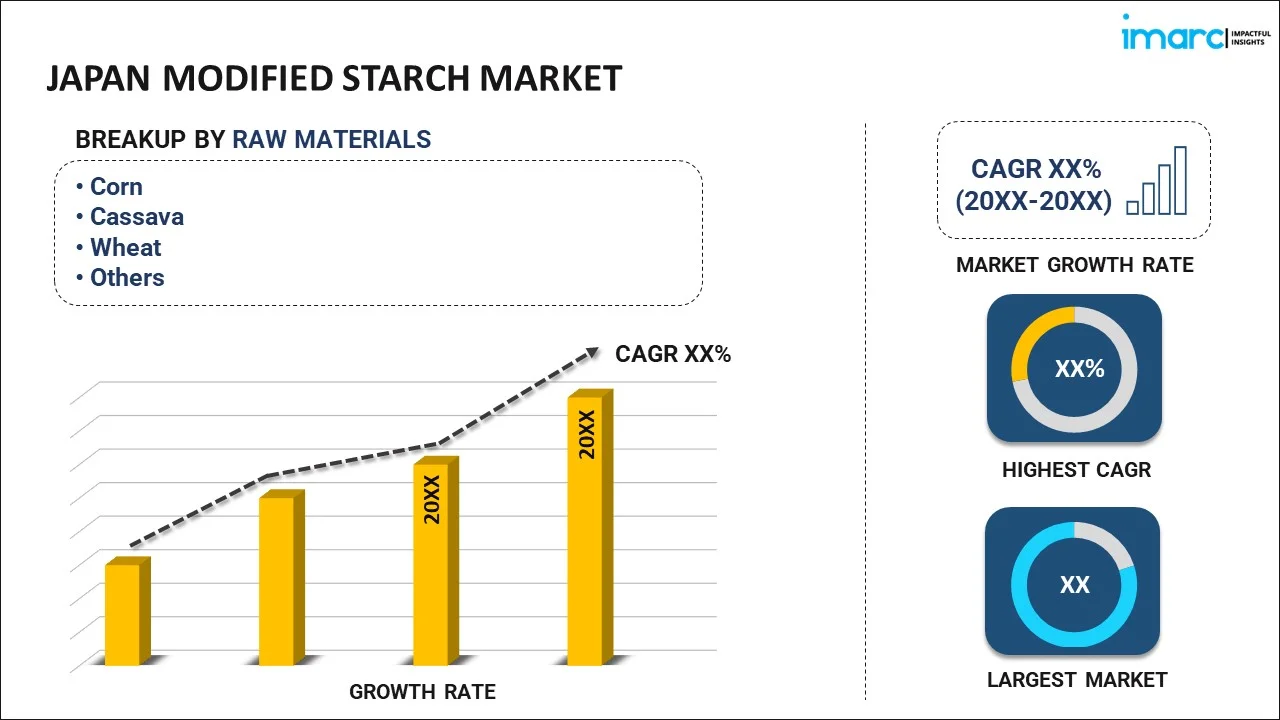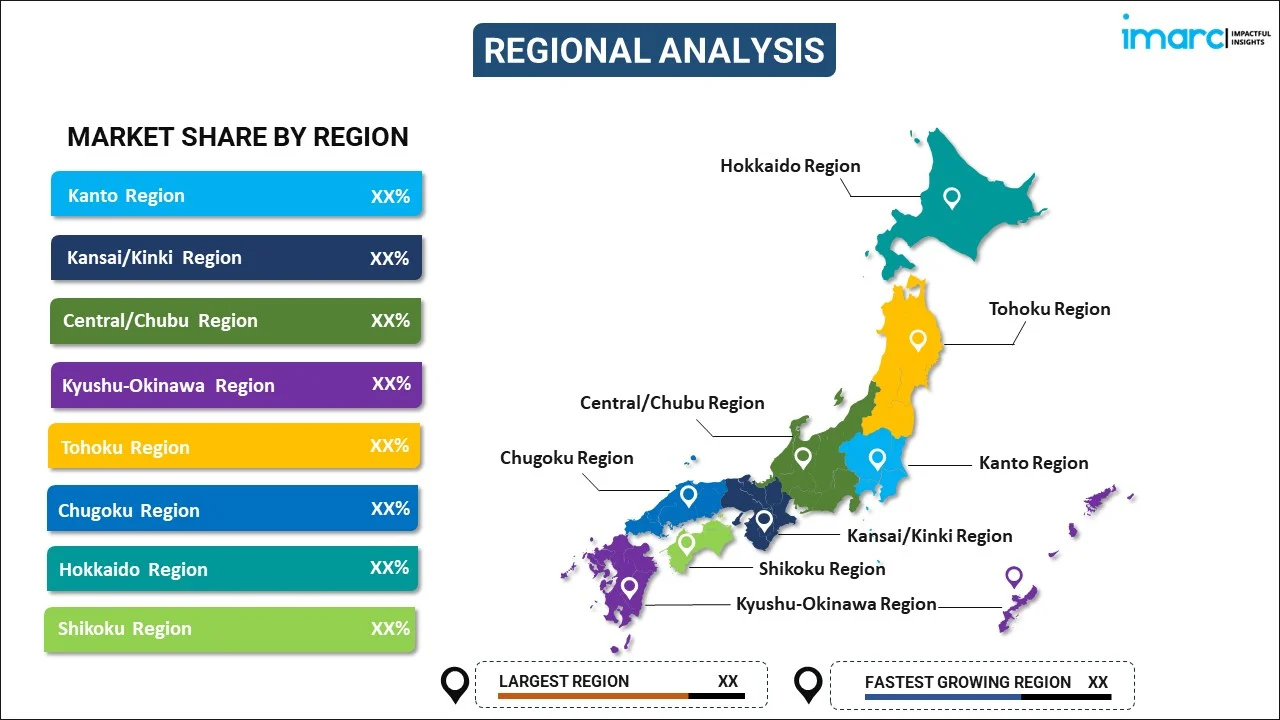
Japan Modified Starch Market Report by Raw Material (Corn, Cassava, Wheat, Potato, and Others), Type (Starch Esters and Ethers, Resistant, Cationic, Pre-gelatinized, and Others), Function (Thickeners, Stabilizers, Binders, Emulsifiers, and Others), Application (Food and Beverages, Animal Feed, Paper, Pharmaceuticals, Textiles, and Others), and Region 2025-2033
Market Overview:
Japan modified starch market size reached USD 422.3 Million in 2024. Looking forward, IMARC Group expects the market to reach USD 750.6 Million by 2033, exhibiting a growth rate (CAGR) of 6.1% during 2025-2033. The market is being driven by several key factors, including the extensive use of the product as a thickening agent, stabilizer, and emulsifier in various food items, the increasing awareness among consumers and their demand for products with clean labels, and the introduction of precise customization options.
|
Report Attribute
|
Key Statistics
|
|---|---|
|
Base Year
|
2024 |
|
Forecast Years
|
2025-2033
|
|
Historical Years
|
2019-2024
|
| Market Size in 2024 | USD 422.3 Million |
| Market Forecast in 2033 | USD 750.6 Million |
| Market Growth Rate (2025-2033) | 6.1% |
Modified starch refers to a derivative of starch that has undergone physical, chemical, or enzymatic treatments to alter its inherent properties. The primary objective behind these modifications is to enhance the performance of starch in a range of applications, encompassing food processing, pharmaceuticals, and textiles. Modified starch offers several advantages, including heightened water-holding capacity, enhanced texture, and increased resistance to heat. For instance, within the realm of food processing, it frequently serves as a thickening agent, stabilizer, or emulsifier. In the pharmaceutical sector, it finds utility as a disintegrant or binder in tablet formulations. The modification process employs various techniques such as hydrolysis, oxidation, or cross-linking, all of which result in structural changes at the molecular level, rendering the starch more suitable for specific purposes. It is imperative to emphasize that meticulous control must be exercised during the modification process to ensure safety and efficacy in line with the intended application. Consequently, modified starches represent a versatile and indispensable component across diverse industries, offering improved attributes compared to their native starch counterparts.
Japan Modified Starch Market Trends:
The modified starch market in Japan experiences robust growth, driven by various key factors. Notably, the surging demand within the food and beverage sector serves as a primary driver. Modified starch finds extensive application as a thickening agent, stabilizer, and emulsifier in an array of food products, including sauces, soups, and baked goods. As consumers increasingly favor convenience foods offering extended shelf life and improved texture, the adoption of modified starch has witnessed a notable uptick. Furthermore, there is a marked increase in consumer consciousness and a heightened preference for clean label products. Consumers are actively seeking natural and organic ingredients, which has propelled the demand for modified starches meeting clean label criteria, such as those sourced from non-GMO or organic origins. Additionally, the rising popularity of vegetarian and vegan diets has led to an augmented need for plant-based products, where modified starches play a pivotal role in texture enhancement and stabilization. The animal feed market further contributes to the demand for modified starch, utilized as binders and energy-providing components in animal feeds. Moreover, the introduction of precise customization of starch characteristics, resulting in tailored products that align with specific industrial requirements, fosters a positive market outlook.
Japan Modified Starch Market Segmentation:
IMARC Group provides an analysis of the key trends in each segment of the market, along with forecasts at the country level for 2025-2033. Our report has categorized the market based on raw material, type, function, and application.
Raw Material Insights:

- Corn
- Cassava
- Wheat
- Potato
- Others
The report has provided a detailed breakup and analysis of the market based on the raw material. This includes corn, cassava, wheat, potato, and others.
Type Insights:
- Starch Esters and Ethers
- Resistant
- Cationic
- Pre-gelatinized
- Others
A detailed breakup and analysis of the market based on the type have also been provided in the report. This includes starch esters and ethers, resistant, cationic, pre-gelatinized, and others.
Function Insights:
- Thickeners
- Stabilizers
- Binders
- Emulsifiers
- Others
The report has provided a detailed breakup and analysis of the market based on the function. This includes thickeners, stabilizers, binders, emulsifiers, and others.
Application Insights:
- Food and Beverages
- Animal Feed
- Paper
- Pharmaceuticals
- Textiles
- Others
A detailed breakup and analysis of the market based on the application have also been provided in the report. This includes food and beverages, animal feed, paper, pharmaceuticals, textiles, and others.
Regional Insights:

- Kanto Region
- Kansai/Kinki Region
- Central/ Chubu Region
- Kyushu-Okinawa Region
- Tohoku Region
- Chugoku Region
- Hokkaido Region
- Shikoku Region
The report has also provided a comprehensive analysis of all the major regional markets, which include Kanto Region, Kansai/Kinki Region, Central/ Chubu Region, Kyushu-Okinawa Region, Tohoku Region, Chugoku Region, Hokkaido Region, and Shikoku Region.
Competitive Landscape:
The market research report has also provided a comprehensive analysis of the competitive landscape in the market. Competitive analysis such as market structure, key player positioning, top winning strategies, competitive dashboard, and company evaluation quadrant has been covered in the report. Also, detailed profiles of all major companies have been provided.
Japan Modified Starch Market Report Coverage:
| Report Features | Details |
|---|---|
| Base Year of the Analysis | 2024 |
| Historical Period | 2019-2024 |
| Forecast Period | 2025-2033 |
| Units | Million USD |
| Scope of the Report | Exploration of Historical and Forecast Trends, Industry Catalysts and Challenges, Segment-Wise Historical and Predictive Market Assessment:
|
| Raw Materials Covered | Corn, Cassava, Wheat, Potato, Others |
| Types Covered | Starch Esters and Ethers, Resistant, Cationic, Pre-gelatinized, Others |
| Functions Covered | Thickeners, Stabilizers, Binders, Emulsifiers, Others |
| Applications Covered | Food and Beverages, Animal Feed, Paper, Pharmaceuticals, Textiles, Others |
| Regions Covered | Kanto Region, Kansai/Kinki Region, Central/Chubu Region, Kyushu-Okinawa Region, Tohoku Region, Chugoku Region, Hokkaido Region, Shikoku Region |
| Customization Scope | 10% Free Customization |
| Post-Sale Analyst Support | 10-12 Weeks |
| Delivery Format | PDF and Excel through Email (We can also provide the editable version of the report in PPT/Word format on special request |
Key Questions Answered in This Report:
- How has the Japan modified starch market performed so far and how will it perform in the coming years?
- What has been the impact of COVID-19 on the Japan modified starch market?
- What is the breakup of the Japan modified starch market on the basis of raw material?
- What is the breakup of the Japan modified starch market on the basis of type?
- What is the breakup of the Japan modified starch market on the basis of function?
- What is the breakup of the Japan modified starch market on the basis of application?
- What are the various stages in the value chain of the Japan modified starch market?
- What are the key driving factors and challenges in the Japan modified starch?
- What is the structure of the Japan modified starch market and who are the key players?
- What is the degree of competition in the Japan modified starch market?
Key Benefits for Stakeholders:
- IMARC’s industry report offers a comprehensive quantitative analysis of various market segments, historical and current market trends, market forecasts, and dynamics of the Japan modified starch market from 2019-2033.
- The research report provides the latest information on the market drivers, challenges, and opportunities in the Japan modified starch market.
- Porter's five forces analysis assist stakeholders in assessing the impact of new entrants, competitive rivalry, supplier power, buyer power, and the threat of substitution. It helps stakeholders to analyze the level of competition within the Japan modified starch industry and its attractiveness.
- Competitive landscape allows stakeholders to understand their competitive environment and provides an insight into the current positions of key players in the market.
Need more help?
- Speak to our experienced analysts for insights on the current market scenarios.
- Include additional segments and countries to customize the report as per your requirement.
- Gain an unparalleled competitive advantage in your domain by understanding how to utilize the report and positively impacting your operations and revenue.
- For further assistance, please connect with our analysts.
 Inquire Before Buying
Inquire Before Buying
 Speak to an Analyst
Speak to an Analyst
 Request Brochure
Request Brochure
 Request Customization
Request Customization




.webp)




.webp)












